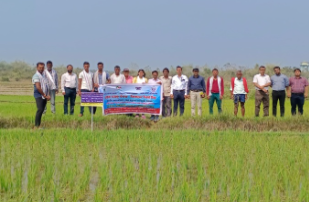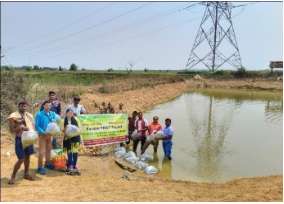Amidst the rainfed and partially irrigated landscapes of Haridamada, Jamujhari and Barapita villages in Khordha district, agriculture has long been the backbone of tribal and smallholder households. These villages, situated within the East and South Eastern Coastal Plain agro-climatic region, experience a tropical monsoon climate with 1,100–1,200 mm annual rainfall, variable soil textures, and highly uneven water availability. The combination of small landholdings, dependence on rainfed farming, and inadequate access to certified seeds and efficient water management practices had historically constrained crop productivity and rural incomes.
Recognizing these challenges, ICAR–Indian Institute of Water Management, Bhubaneswar, initiated the Farmer FIRST Programme (FFP) in December 2022 with a mission to transform the livelihoods of this predominantly tribal cluster. With nearly 450 households 45% belonging to scheduled tribes the region presented a compelling opportunity for introducing location-specific, water-smart, and integrated farming technologies.

Driving Change Through Multi-Dimensional Interventions
The FFP interventions were implemented through five thematic modules crop-based, natural resource management, horticulture, livestock, and enterprise-based activities ensuring holistic growth of the farming system.
Crop-Based Interventions
Certified high-yielding rice varieties (HYVs) were introduced across seasons on 75 acres, supported with scientific practices such as line transplanting, bio-fertilizer-based seed treatments, and Rhizobium-inoculated green gram in rice fallows. These demonstrations achieved 10–20% yield gains, improved benefit-cost ratios, and enhanced both physical and economic water productivity.
Natural Resource Management (NRM) Technologies
NRM interventions such as dug-out sunken ponds, dyke-height optimization, polythene mulching, and mini Integrated Farming System (IFS) models helped conserve rainfall, improve irrigation availability, and boost water-use efficiency. Construction of water harvesting structures and piped irrigation ensured timely application of lifesaving irrigation, particularly in critical crop stages.

Horticulture-Based Interventions
To enhance nutrition and income, hybrid vegetable seeds and IIHR-designed Nutri-Garden kits were distributed. This not only diversified household diets but also brought previously unused uplands under productive use during the rabi season.
Enterprise Development for Income Enhancement
Mushroom cultivation and vermicomposting introduced under the enterprise module opened new avenues for farm-based income. These enterprises supported organic agriculture while creating parallel income streams.
Livestock-Based Interventions
Improved poultry breeds like Vanaraja, RIR, Kaveri, and Vejaguda significantly enhanced egg production from 30–40 eggs/year in local birds to 137–205 eggs/year in improved breeds. Dairy animals were supported through mineral mixtures and improved management. Fishery in local ponds was augmented through stocking of Indian Major Carps, helping households improve protein access and income.

Validating a Successful Technological Model
Through participatory trials, farmers adopted certified seed varieties such as MTU 1061, Swarna Sub-1, CR Dhan 314, CR Dhan 206, Binadhan 11, and others each selected based on ecosystem suitability and farmer preference. Scientific practices including seed treatment with Trichoderma, improved nursery management, pre- and post-emergence herbicide application, balanced nutrient management, and insect pest control significantly enhanced productivity.
Location-specific water management practices, including maintaining field bunds, ensuring optimal dyke height, rainwater conservation, and irrigation scheduling at 2–3 days after disappearance of ponded water, demonstrated 20–25% irrigation water savings in summer rice.
As a result, farmers achieved 10–12 t/ha system yield, reduced cultivation costs, and significantly improved net returns under the rice–rice cropping system.
Crop Diversification: A Turning Point Toward Atmanirbhar Krishi
Before the project, most farmers cultivated only kharif rice and managed small kitchen gardens. With FFP support, farmers began using upland fallows to grow commercial vegetables in rabi, supported by assured irrigation from sunken ponds and piped systems.
Nearly 20 acres of fallow land were brought under high-value vegetables such as tomato, okra, brinjal, bitter gourd, cowpea, cauliflower, and leafy greens. Yields ranged from 14.25 28.5 t/ha, delivering annual incomes between ₹1.32 lakh and ₹6.65 lakh per hectare a transformative shift from subsistence to market-oriented farming.
A Champion Farmer Emerges: The Journey of Shri Manas Kumar Das
Among the many success stories, Shri Manas Kumar Das of Haridamada village stands out as a role model of integrated, scientific, and profitable farming.
With 3.5 acres of land and a leased village pond, he adopted paddy, vegetables, pulses, dairy, and fishery enterprises strategically integrating them with ICAR-IIWM technologies such as:
• High-yielding rice varieties
• Trellis-based vegetable cultivation
• Pond-based irrigation
• Ridge and furrow water management
• Bio-fertilizers and eco-friendly pest control
• Crop diversification with sequential vegetable crops
• Scientific fish farming with Indian Major Carps
His enterprise generated ₹3.56 lakh annual farm income, supplemented by ₹1.80 lakh earned as a skilled mason taking his total annual income to ₹5.46 lakh.
His exemplary initiative and leadership earned him the Progressive Farmer Award 2025 by ICAR–NAARM, Hyderabad. He is widely regarded as a torch-bearer of scientific farming in the region.

Conclusion: A Model for Viksit Bharat 2047
The carefully designed, farmer-centric technological interventions of the Farmer FIRST Programme have transformed the tribal cluster from a rainfed challenge zone into a model hub of profitable, resource-efficient, and diversified agriculture.
Through technology adoption, capacity building, and strong farmer–scientist linkages:
• Water productivity improved
• Crop yields increased
• Household nutrition improved
• Income rose substantially
• Youth engagement in agriculture strengthened
Success stories like that of Shri Manas Kumar Das highlight the transformative power of FFP in achieving national goals of Doubling Farmers' Income, Atmanirbhar Krishi, and Viksit Bharat 2047.
(Source: ICAR-Central Institute for Women in Agriculture, Bhubaneswar)








Like on Facebook
Subscribe on Youtube
Follow on X X
Like on instagram